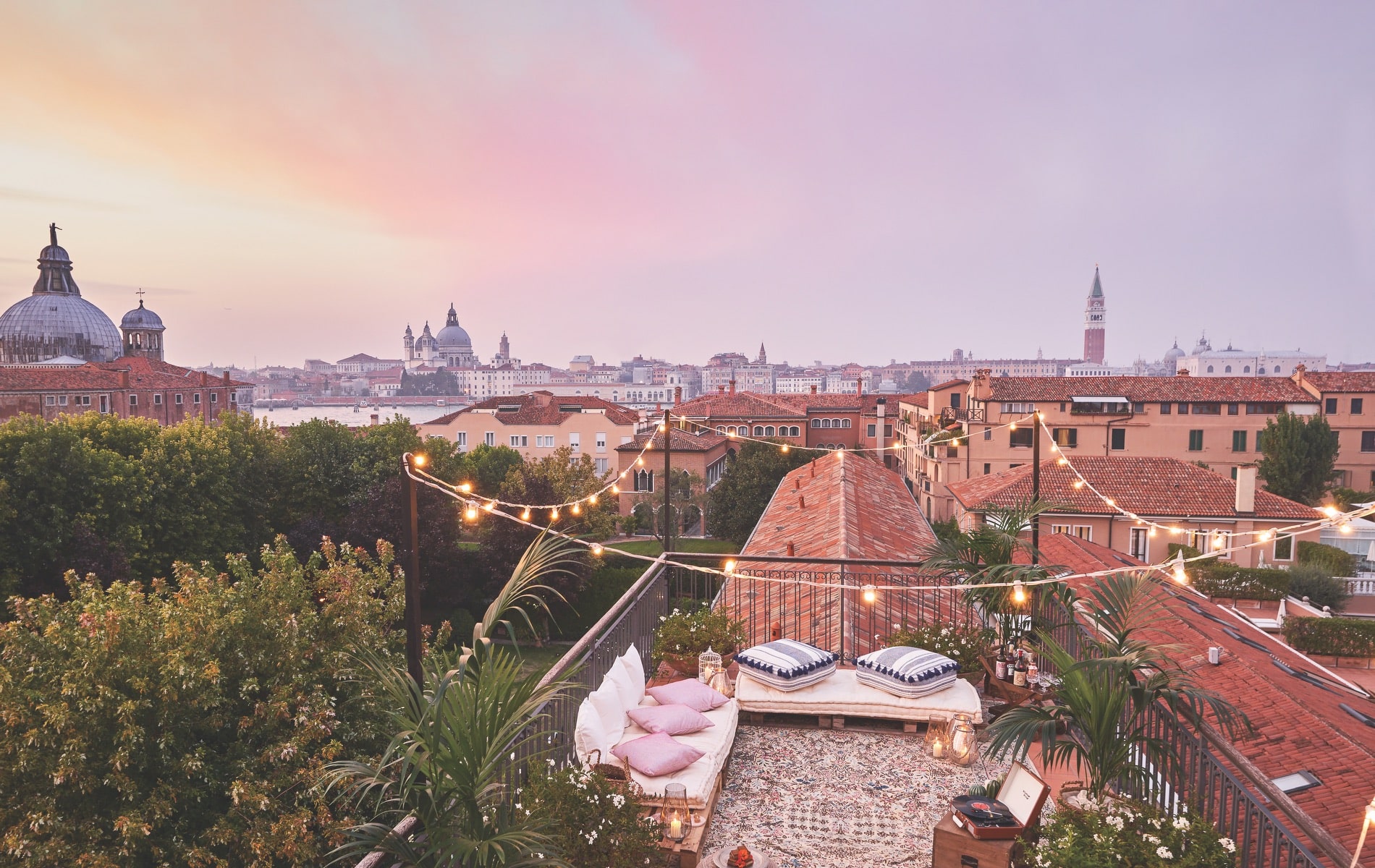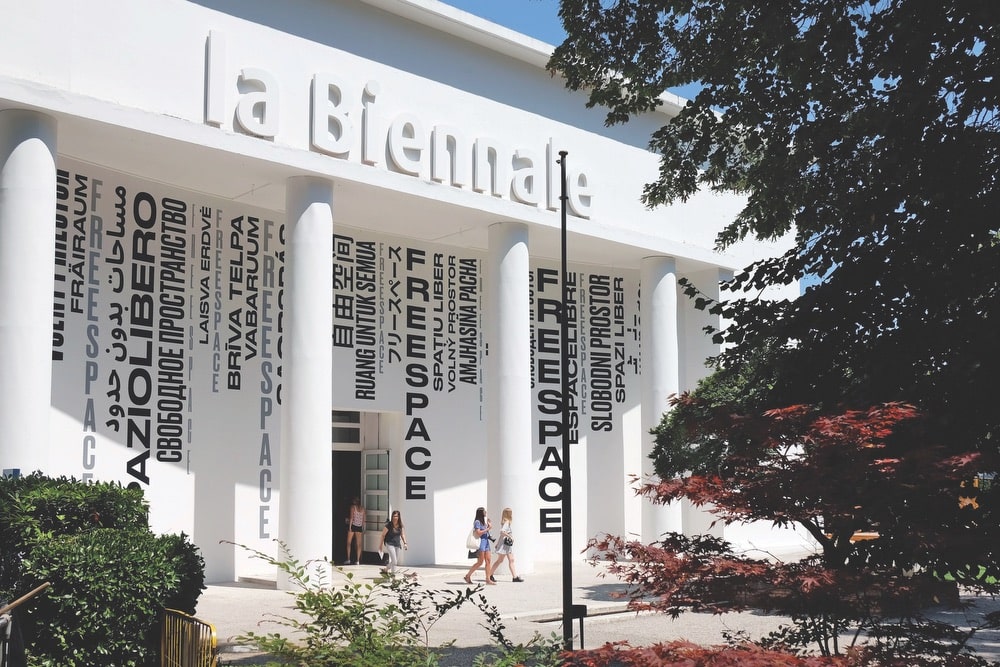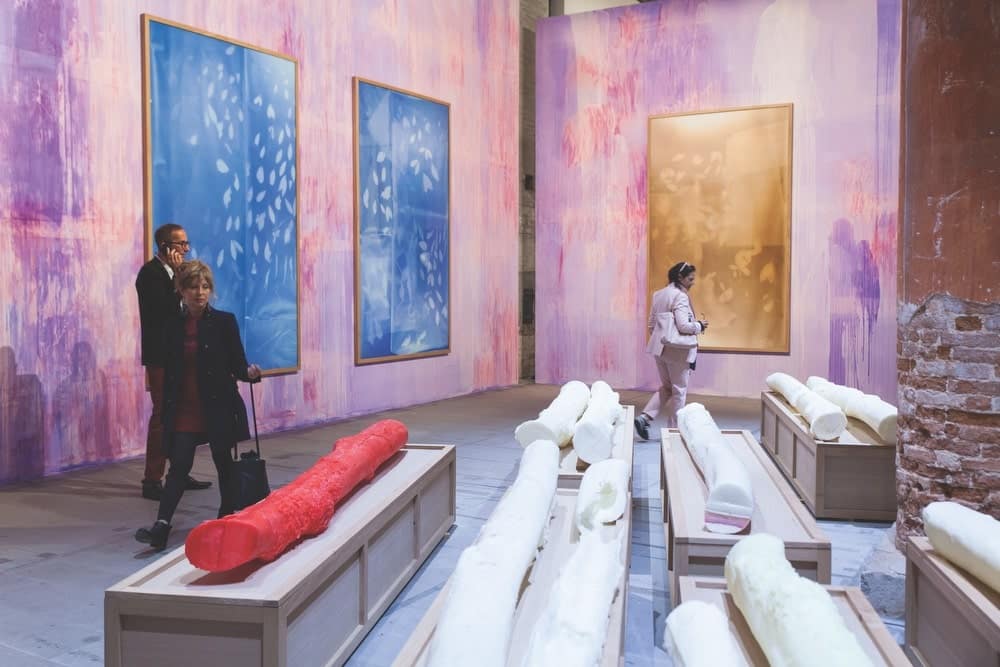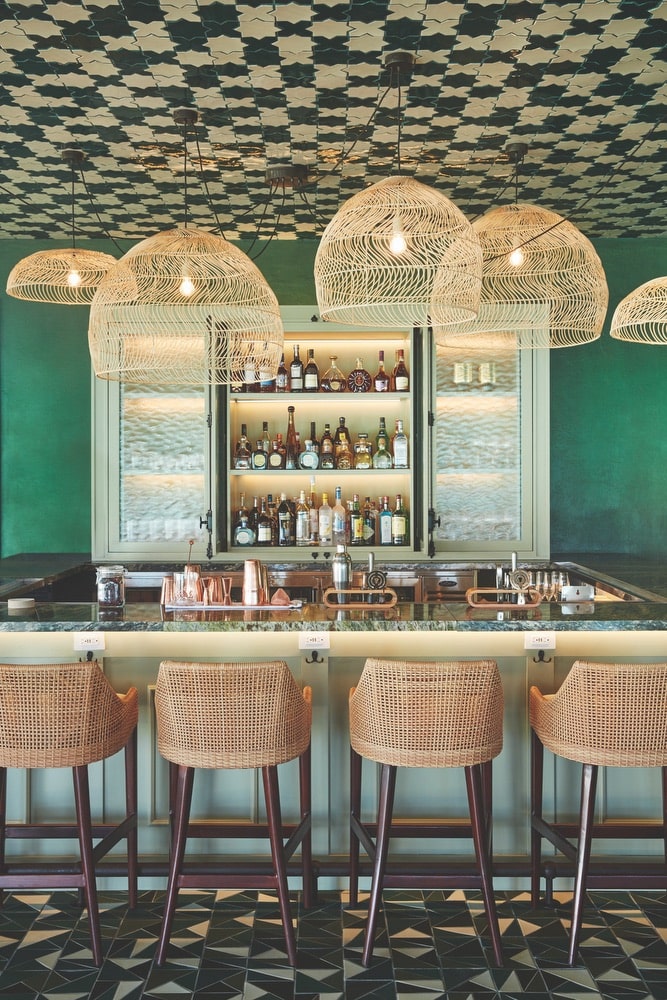
VIE_Magazine_OCT22_article_Venice_Biennale_HERO-min
The Cipriani, a Belmond hotel, recommends a sunset party overlooking the water to close out a day full of sightseeing in Venice. Photo by Tyson Sadio, courtesy of Belmond
Viva Venezia!
A Convergence of Art and Dreams
By Anthea Gerrie
It’s the late, late show for culture vultures who are also bon vivants—the final golden weeks of that unmissable international artfest, the Venice Biennale. No ordinary visual spectacular, it features world-class painting, sculpture, film, and installations from every corner of the planet in La Serenissima, with its sublimely romantic places to stay, eat, and get lost crossing canals when the galleries are closed.
Why go? Because it’s full of things you will otherwise never see assembled all in one city, given how seldom artists from remote corners of the world get exposure in mainstream galleries or museums. This 59th Biennale, the first in three years, features the work of 213 artists from 58 countries and is also the first in which more women than men are exhibiting.

Bruno Catalano sculpture at Galleria Ravagnan, San Marco, during the 2022 Venice Biennale | Photo by Anthea Gerrie
Why make the trip now? Because the art critics who spent April and May disseminating the best of what to see are long gone, as are the tourists who crowded the galleries over summer. Their departure leaves only the art to be enjoyed in peace during a warm, gilded fall until November 27, when this year’s show will close.
The variety and quality of its offerings make the Venice Biennale unique. In a single day this summer, I feasted my eyes on sequined, flag-like hangings from Haiti; mysterious watercolors from the Congo; huge, powerful rope-women woven in India; and dreamy videos telling stories of love, loss, and fragile local architecture on the Mekong Delta in Vietnam.

The scenic monumental sculpture of a child’s hands, Support by Lorenzo Quinn, installed in the Grand Canal of Venice during the 2018 exhibition | Photo by Marco Rubino/Shutterstock
The waterside palazzi, which take on a starring role during Biennale season, are shown in tandem with the main exhibition sites, like Peggy Guggenheim’s exquisite house-turned-museum on the Grand Canal—this year’s home to the best show of the season. The national pavilions showcasing the work of the artist picked to represent each country are now merely the bones of the experience; watch out for eye-popping work elsewhere that never had to go through jury selection. Example: the deconstructed mannequins that stopped me in my tracks while I peered into what I assumed was a fashion boutique on the Piazza San Marco. It was actually the Galleria Ravagnan, and the “mannequins” turned out to be Bruno Catalano sculptures profound with meaning: their elegant hollows represent the memories we lose as we move through life; the suitcases they clutch depict the baggage we keep with us to the end.

The 16th International Architecture Exhibition La Biennale di Venezia, 2018 | Photo by Tetiana Tuchyk/Shutterstock
In 2022 much has changed at Biennale, not only because female artists outnumber men. The tone has turned ever more political—this year’s theme title, The Milk of Dreams, is as much about women being visible as the surrealists it celebrates. Although the war stopped the intended Ukrainian pavilion, the country was still prominently represented by a highly visible tower of sandbags. Slavery and colonialism were addressed in the US pavilion, while the Scandinavians used theirs to showcase the native Sami people whose creative contribution has been overlooked for centuries.
There’s so much more to see than the exhibitions in the Giardini—the gardens that are the permanent home of most national pavilions—and the endless galleries of the nearby Arsenale. Still, these two official sites make the most logical starting point. The central theme pavilion in the Giardini is packed with the highly engaging work of women artists, both living and late-greats like Paula Rego, Dorothea Tanning, and Leonora Carrington, as well as less well-known but equally magnificent surrealists Remedios Varo and Leonor Fini. Their work is showcased in the slightly subterranean Witches’ Cradle, where two whole rooms are devoted to Rego and her startling installations featuring scary rag dolls and fallen women, as well as the figure paintings for which she is most famous.

Installation view of Thu Van Tran’s work at the 57th Venice Biennale, 2017 | Photo by Bepsy/Shutterstock
Other highlights of the Giardini include the US pavilion featuring Simone Leigh’s massive sculptures of handsome slave women. There is also a fascinating series of what looks like room sets for a 1960s New Wave movie in the French pavilion, created by Zineb Sedira for her highly engaging Dreams Have No Titles. Venture from the life-size bar to the living room, with its period movie posters, and the dressing room hung with a rail full of vintage dresses. This is a back-to-the-future fantasy ride that visitors are reluctant to leave behind.
The Giardini is never hard to tackle, thanks to a wealth of shade, seating, and refreshment points, but the Arsenale requires more stamina. I suggest making this stretch of galleries, which seems to extend nearly a mile from one end of an ancient naval building to the other, the first site of the day to tackle after a double macchiato.
Shown in tandem with the main exhibition sites, like Peggy Guggenheim’s exquisite house-turned-museum on the Grand Canal—this year’s home to the best show of the season.

View of the Arsenale during the 58th Venice Biennale, titled May You Live in Interesting Times, 2019 | Photos by Bepsy/Shutterstock
A respite from the endless halls, over which Simon Leigh’s towering, eyeless black female stands sentinel, comes from screening rooms that seduce with irresistible films and force a slowdown to take in the best. Not to be missed are the tales of love and loss filmed on the Mekong Delta by Vietnamese artist Thao Nguyen Phan. Her unlikely characters include local architectural motifs and the role played in marriage by the controversial durian fruit, famously said to taste like heaven but smell like hell. Don’t ask—just sit, rest your sore feet, take in the beautiful images, and dream of Vietnam and Cambodia through Phan’s lens.

Wind down at Cip’s by Cipriani during your stay. | Photo by Richard James Taylor, courtesy of Belmond
Dreams are in plentiful supply across the lagoon at the Peggy Guggenheim Collection, the loveliest art museum in Venice—and perhaps the world—at any time of year. This year’s Surrealism and Magic exhibition features many of the female artists showcased in the Giardini in greater depth and with arguably more engaging work. However, don’t miss the main gallery building for its exquisite wall of blue glass sculptures based on Picasso drawings, custom-made for Peggy by a local artisan. Like the museum’s lovely terrace, they overlook the Grand Canal and offer a welcome pause to reflect on the sheer joy of being in this most visual and haunting of European cities.
When it comes to where to stay and eat, the Cipriani family has dominated the Venice hospitality scene for close to a century. Arrigo “Harry” Cipriani, named after the restaurant founded by his father, is still in attendance, at age ninety, every lunchtime at Harry’s Bar. Any trip to La Serenissima should start with one of their legendary Bellinis made with fresh peach juice. Of course, you can eat here, too, but the view is more special across the lagoon at Harry’s Dolci, which serves all the favorites from the family recipe book in a beautiful waterside setting.

Building Bridges, located in the harbor, is one of 2022’s most inspiring works at the Venice Biennale. | Photo by Simlinger/Shutterstock
Harry’s Dolci is on the island of Giudecca, down the road from the Cipriani—still the best five-star hotel in Venice, even though the founding family no longer owns it. It is part of the prestigious Belmond collection, so guests are in great hands. Even if you are not staying, don’t miss lunch at the hotel’s glorious new alfresco seafood restaurant, Il Porticciolo—especially recommended for its raw plate and divine lemon sherbet served in a frozen shell. George Clooney is said to be a fan of the hotel’s bar, but for his stag night, he chose Da Ivo back in busy San Marco, which is accustomed to serving “picky” Americans. The decor of this tiny but perfectly formed trattoria is movie-set Italian, its service impeccable, and its langoustines and beefsteak alla fiorentina to die for. It’s possible to arrive and depart by gondola, given the restaurant’s romantic canal-side location.
When it comes to where to stay and eat, the Cipriani family has dominated the Venice hospitality scene for close to a century.

Visitors enjoying the Norwegian pavilion at the 2021 Venice Biennale, How Will We Live Together? | Photo by Simone Padovani/Shutterstock
Venice has hosted several five-star hotel openings this year, two particularly appropriate for Biennale-goers. The Radisson Palazzo Nani, an exquisite new conversion of a seventeenth-century home, sits on the atmospheric Cannaregio Canal. It is opposite the Palazzo Manfrin, recently taken over by sculptor Anish Kapoor, who has packed the ancient house with mountains of red wax and piles of scarlet, black, and cobalt pigment, as well as his signature mirrored surfaces. More central is Ca’ di Dio, a luxe medieval monastery conversion behind the Arsenale vaporetto stop, ideally placed to walk to both of the main Biennale sites, with a sidewalk restaurant perfect for people-watching.
Remember that the Arsenale and Giardini are closed on Mondays, while the Guggenheim closes on Tuesdays. Plan a visit accordingly, as all three are unmissable—the stuff of memories to sustain the lover of fine art until fresh excitement returns to La Serenissima with the next beautiful Biennale in April 2024.
— V —
Learn more or plan your trip at LaBiennale.org and VisitVenezia.eu.
Share This Story!
KEEP UP WITH THE LATEST STORIES FROM VIE
















































































































































